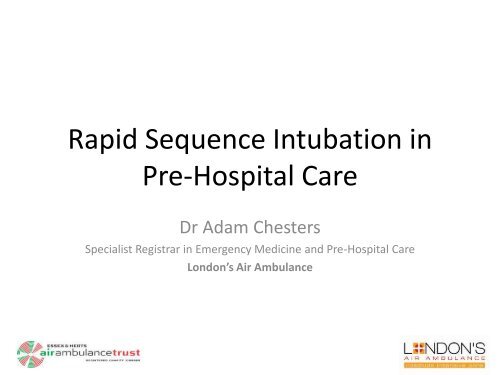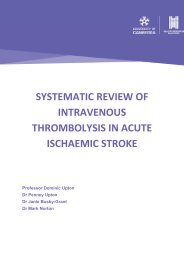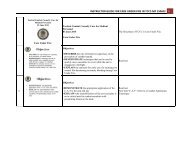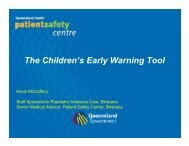RSI at LAA
RSI at LAA
RSI at LAA
Create successful ePaper yourself
Turn your PDF publications into a flip-book with our unique Google optimized e-Paper software.
Rapid Sequence Intub<strong>at</strong>ion in<br />
Pre-Hospital Care<br />
Dr Adam Chesters<br />
Specialist Registrar in Emergency Medicine and Pre-Hospital Care<br />
London’s Air Ambulance
CV<br />
• University of Leicester Medical School<br />
• Emergency Medicine, Anaesthetics, Critical Care<br />
John Radcliffe Hospital<br />
Noble’s Hospital<br />
Northern General Hospital<br />
West Suffolk Hospital<br />
Addenbrooke’s Hospital<br />
St Mary’s Hospital<br />
• Pre-Hospital and Retrieval<br />
Essex and Herts Air Ambulance<br />
East Anglian Air Ambulance<br />
Children’s Acute Transport Service<br />
London’s Air Ambulance<br />
Oxford<br />
Isle of Man<br />
Sheffield<br />
Bury St Edmunds<br />
Cambridge<br />
London
For the purposes of this talk...<br />
• Accept th<strong>at</strong> pre-hospital <strong>RSI</strong> is beneficial to<br />
certain seriously injured p<strong>at</strong>ients<br />
• Think about robust systems and safe techniques
Things to think about...<br />
• London’s Air Ambulance<br />
– Description of the process<br />
– L<strong>at</strong>est st<strong>at</strong>istics<br />
• Pre-hospital rapid sequence intub<strong>at</strong>ion<br />
– Who benefits?<br />
– Do we need drugs?<br />
– Do we need doctors?<br />
– Do we need a system?
London’s Air Ambulance<br />
Philosophy for pre-hospital intub<strong>at</strong>ion:<br />
1. None of our p<strong>at</strong>ients should have to wait to<br />
get an anaesthetic if they need one<br />
2. Technique must be safe and reproducible<br />
3. The first <strong>at</strong>tempt <strong>at</strong> intub<strong>at</strong>ion must have the<br />
maximum chance of success
London’s Air Ambulance<br />
• 25,000 missions since launch in 1989<br />
• 20-30% of all p<strong>at</strong>ients seen get <strong>RSI</strong><br />
• Experience of over 6000 pre-hospital <strong>RSI</strong>s
London’s Air Ambulance<br />
• Simple algorithm for <strong>RSI</strong>:<br />
– <strong>RSI</strong> required?<br />
– If yes, perform standard <strong>RSI</strong> technique<br />
– Fail to intub<strong>at</strong>e after failed intub<strong>at</strong>ion drills?<br />
• Surgical airway or supraglottic device<br />
EXACTLY THE SAME EVERY TIME
The Process<br />
1. Decision<br />
2. Form a team<br />
3. Maximum pre-oxygen<strong>at</strong>ion<br />
4. Kit dump and equipment prepar<strong>at</strong>ion<br />
5. Check list<br />
6. Anaesthetic drugs<br />
7. Intub<strong>at</strong>ion<br />
8. Confirm<strong>at</strong>ion<br />
9. Maintenance of anaesthesia<br />
10.Journey to hospital<br />
11.Handover to hospital team
1. Decision<br />
Simple criteria:<br />
1. Unconscious<br />
2. Agit<strong>at</strong>ed head injuries<br />
3. Airway compromise<br />
4. Ventil<strong>at</strong>ory failure<br />
5. Anticip<strong>at</strong>ed clinical course<br />
Traum<strong>at</strong>ic brain injury<br />
Pre-hospital mortality<br />
In-hospital mortality<br />
6. Humanitarian reasons
2. Form a team
3. Maximum Pre-oxygen<strong>at</strong>ion
4. ‘Kit Dump’
Move the p<strong>at</strong>ient to the kit...<br />
• Cre<strong>at</strong>e a working space to deliver anaesthetic<br />
• 360 access to p<strong>at</strong>ient<br />
• Shaded from sunlight<br />
• Lit <strong>at</strong> night<br />
• Quiet (engines, phones, radios turned off)<br />
• Paramedic lays out equipment while doctor<br />
finishes p<strong>at</strong>ient assessment and briefs team<br />
• Near to ambulance for loading
5. <strong>RSI</strong> Checklist<br />
•Allows period of oxygen<strong>at</strong>ion<br />
•Equipment present<br />
•Equipment working<br />
•Optimise first <strong>at</strong>tempt<br />
•Back up plan understood
6. Anaesthetic drugs
Choice of drugs<br />
• Etomid<strong>at</strong>e<br />
• Suxamethonium<br />
• Pancuronium<br />
• Morphine and Midazolam<br />
Pick suitable drugs for the service and make<br />
sure all personnel know them in detail<br />
EXACTLY THE SAME EVERY TIME
7. Intub<strong>at</strong>ion
Maximising chance of success<br />
• Prepar<strong>at</strong>ion<br />
– Good team work and using a check list<br />
• Positioning<br />
– 360 access to the p<strong>at</strong>ient<br />
– P<strong>at</strong>ient <strong>at</strong> waist height on ambulance trolley<br />
– Oper<strong>at</strong>or kneeling <strong>at</strong> head of p<strong>at</strong>ient<br />
– Cervical spine collar removed<br />
• Help<br />
– Bougie every time<br />
– Skilled assistant<br />
– Well rehearsed failed intub<strong>at</strong>ion drill
8. Confirm<strong>at</strong>ion
9. Maintain anaesthesia and monitor
10. Load and convey
11. Handover to the hospital
<strong>RSI</strong> and the ‘anaesthetic package’<br />
• Full monitoring<br />
• Maximum pre-oxygen<strong>at</strong>ion<br />
– adjuncts and sed<strong>at</strong>ion<br />
• Drugs to induce anaesthesia and paralyse<br />
• Intub<strong>at</strong>ion and confirm<strong>at</strong>ion of placement<br />
• A failed airway drill<br />
• Maintenance of anaesthesia<br />
• Appropri<strong>at</strong>e ventil<strong>at</strong>ion str<strong>at</strong>egy
Failure to intub<strong>at</strong>e<br />
• 30 second drills<br />
– Small changes th<strong>at</strong> may make a huge difference<br />
– Can be read out as a check list<br />
• Decision:<br />
– Surgical airway<br />
– Supraglottic device (iGel)
Roles in the team?<br />
• HEMS Doctors<br />
– Intub<strong>at</strong>ion<br />
• HEMS Paramedics<br />
– Very unusual for paramedic to intub<strong>at</strong>e<br />
– Highly skilled assistant<br />
• Equipment laid out and immedi<strong>at</strong>ely to hand<br />
• Passes tube over bougie and <strong>at</strong>taches anaesthetic circuit<br />
• Failed intub<strong>at</strong>ion drills done together<br />
• Support, ideas, reminders<br />
• Retrieves equipment to ensure quick departure
Harris T, Lockey D<br />
Emergency Medicine Journal<br />
2010<br />
January 2006 – May 2007
Snapshot of a different system<br />
• San Diego Paramedic <strong>RSI</strong> Trial (1998 – 2002):<br />
– Paramedic-performed <strong>RSI</strong><br />
– Head injury with GCS
Davis et al. J Trauma. 2002
Dunford et al.<br />
Annals of Emergency Medicine.<br />
42(6). 2003<br />
54 p<strong>at</strong>ients:<br />
31 des<strong>at</strong>ur<strong>at</strong>ed to
San Diego <strong>RSI</strong> Trial<br />
• New system introduced<br />
• Single Paramedic<br />
• 8 hours training<br />
– <strong>RSI</strong><br />
– Medic<strong>at</strong>ions<br />
– Failed airway device<br />
– GCS scoring<br />
– Ventil<strong>at</strong>ion str<strong>at</strong>egies<br />
• ± Very low dose Midazolam<br />
• Cricoid pressure for all<br />
• 60 seconds pre-oxygen<strong>at</strong>ion<br />
• No ETCO2 monitoring<br />
– Inadvertent hyperventil<strong>at</strong>ion<br />
– ‘standard’ settings for all<br />
London’s Air Ambulance<br />
• >6000 <strong>RSI</strong>s completed<br />
• Doctor-Paramedic team<br />
• Senior doctors<br />
– At least 6 months anaesthetics<br />
– Consultants or senior registrars<br />
– Ongoing training<br />
– 30-40 <strong>RSI</strong>s over 6 months<br />
– Constant review of outcomes<br />
• Induction dose Etomid<strong>at</strong>e<br />
• Low threshold for release<br />
• Maximum pre-oxygen<strong>at</strong>ion<br />
• Full monitoring<br />
– ETCO2 key end-point<br />
– Ventil<strong>at</strong>ion titr<strong>at</strong>ed
Robust systems and safe techniques<br />
• London’s Air Ambulance<br />
– Description of the process<br />
– L<strong>at</strong>est st<strong>at</strong>istics<br />
• Pre-hospital rapid sequence intub<strong>at</strong>ion<br />
– Who benefits?<br />
– Do we need drugs?<br />
– Do we need doctors?<br />
– Do we need a system?





